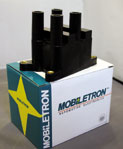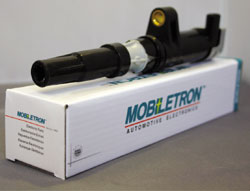
The experts at Mobiletron detail why changes in ignition system technology has created a need for more advanced ignition coils and how technicians can overcome some of the associated issues with these:The

The primary function of the ignition system is to transform the 12 volts from the vehicle battery into over 10,000 volts to produce a spark for combustion.
The earliest ignition systems were comprised of two main elements: the coil itself and a distributor. The distributor was a mechanically driven switch and spark energy was delivered to the spark plug via high voltage cables. Following this technology, mechanical distributor systems were quickly replaced by electrical switching systems.
Distributors were a very inefficient method of energy delivery and so distributor-less ignition was a natural progression for this technology. The high voltages generated were applied directly to the spark plugs, and the ignition control was done by the ECU. This resulted in a much improved efficiency of the ignition system itself.
The most recent types of ignition coil (sometimes described as pencil or stick coils) are single cylinder ignition units applied directly to each spark plug. These can be removed and serviced/replaced individually and often feedback to the ECU a signal relating to ignition current and voltage waveforms. The newest technology (mainly used on smaller turbocharged engines) combines all of the aforementioned technology into a smaller package with longer spark generation and higher spark energy.
This constantly evolving market is a continuous challenge for companies like Mobiletron and we need to use all of our 30 years’ experience devoted to automotive electronics and supplying to OE, OES and the independent aftermarket in order to stay at the forefront of this ever-changing market.
Common Faults
Common ignition system complaints include:
 ■ Complete no start of a vehicle.
■ Complete no start of a vehicle.
■ Difficulty when starting the vehicle. If spark plugs don’t receive the optimal voltage levels from the coil, starting may become difficult in cold or humid conditions.
■ Misfiring whilst the vehicle is running. A misfire is much more noticeable at higher speeds when the vehicle will feel like it is jerking or losing power.
■ Decline in fuel economy. When one or more spark plugs are not generating enough spark energy (or any spark at all) the remaining cylinders must compensate for this loss of power, hence increasing fuel consumption.
■ Stalling when idling.
Identify the Problem

Here are some tips to help to identify the source of ignition system issues:
■ Failure to start a car by its own means or by jump start could signal an ignition coil pack failure.
■ Remember to check HT leads and coil terminals for cracks or damage.
■ Check that all bolts are tightened to the correct torque. Many ignition coils are grounded through the bolts onto the body of the vehicle. Loose bolts can cause a poor grounding and this can waste the spark energy.
■ An oscilloscope can be used to check signals from the coil pack.
■ With pencil or stick coils, try swapping the coils from cylinder to cylinder to see if the misfire follows the coil pack, indicating a faulty product.
■ Lastly, always remember that it is advised to replace pencil coils in sets and, if possible, try to determine why the coil has failed; otherwise the replacement coil may also fail!









